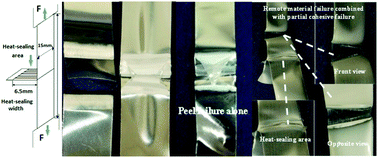Heat seal properties of polymer–aluminum–polymer composite films for application in pouch lithium-ion battery
Abstract
Polymer–metal–polymer composite films are widely used in packaging, building, and cooling, and more recently as envelopes for pouch lithium-ion batteries (LIBs). The influences of heat seal temperature and dwell time on the heat seal strength (HSS) of five different multilayer films were investigated by T-peel testing. The failure modes were observed and analyzed by digital optical microscopy. Heat-sealing temperature and dwell time interacted and simultaneously influenced the HSS. Temperature was confirmed as the primary factor while dwell time was secondary. Failure modes included interfacial failure, cohesive failure, material break (root) alone or combined with partial delamination, material break (remote) or combined with partial cohesive failure, material necking alone or combined with partial cohesive failure were closely related to the HSS. The optimum combinations of temperature and dwell time for each multilayer film were obtained in the respective process windows correlating to different failure modes. The sealant layer thickness and material processing also affected the HSS.


 Please wait while we load your content...
Please wait while we load your content...